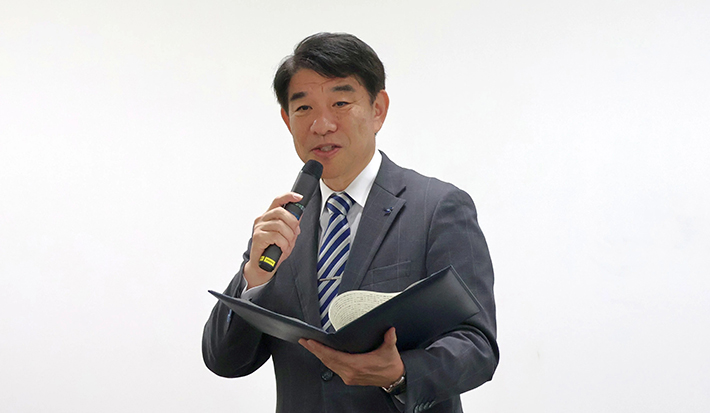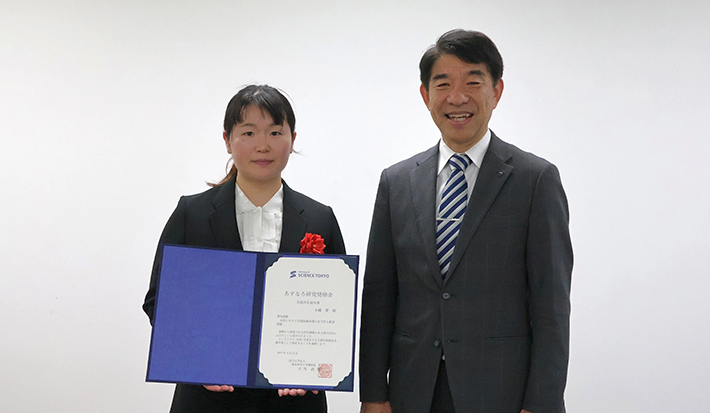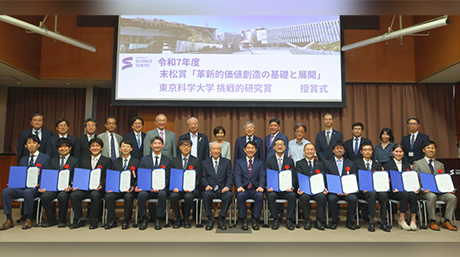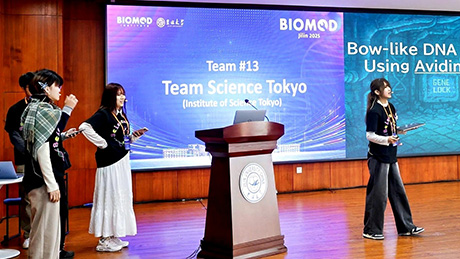Life Science and Technology News
2025 ASUNARO Grant awarded to four researchers
Four researchers received the 2025 ASUNARO Grant, which is financial support for researchers under 45 years of age engaged in basic research. A ceremony to present the researchers with their award notices was held on June 23.

Front row from left : Assistant Professor Ai kohata,Associate Professor Hiroyuki Fujioka,President and Chief Executive Officer Naoto Ohtake, Assistant Professor Tomoyuki Kurioka(online attendance),Assistant Professor Shusuke Sato
The grant was established in FY 2020, in response to the late Professor Emeritus Koichi Asano's wish to donate a portion of the proceeds from his research, saying, "I am grateful to society for the many years of support that allowed my work in basic research to flourish. In return, I would like to use the funds to support basic research by future generations."
This is the five time the Institute has provided the grant for which 41 researchers applied and 4 were selected as recipients.
At the award ceremony, a moment of silence was observed in memory of the late Professor Emeritus Koichi Asano, followed by a congratulatory address from President and CEO Naoto Ohtake, who encouraged the recipients by saying, “When you encounter obstacles in your research, I ask that you try to approach the problem from a different angle, and persevere.

 President and Chief Executive Officer Naoto Ohtake
President and Chief Executive Officer Naoto Ohtake

 Associate Director of Research Development Center (Head URA) Hajime Nitta
Associate Director of Research Development Center (Head URA) Hajime Nitta
FY2025 Recipients of ASUNARO Grant
Associate Professor Hiroyuki Fujioka
Department of Physics, School of Science
Research Topic :Detailed Study on Low-Energy Antineutron Production to Unveil the Mystery of Matter-Dominated Universe


Our current universe is made of matter. While this might seem obvious, when the universe was born, antimatter, which has opposite properties to matter, was created in equal amounts together with matter. Since matter and antimatter annihilate each other when they collide, nothing should have remained. However, for some unknown reason, matter had a tiny surplus over antimatter (just one part in a billion), which led to our current matter-dominated universe. It remains one of the greatest unsolved puzzles in modern physics.
One of the necessary conditions for creating a matter-dominated universe (known as Sakharov’s three conditions) is the existence of processes that don’t conserve baryon number. Neutron-antineutron oscillation is predicted to be one such process. We plan a future experiment at a research reactor, in which we will trap ultracold neutrons in a storage bottle to search for neutron-antineutron oscillations. However, we don’t fully understand what happens when antineutrons hit a bottle wall.
This research aims to study low-energy antineutron production at CERN’s Antiproton Decelerator (AD) facility, to conduct scattering experiments between low-energy antineutrons and atomic nuclei.
- Hiroyuki Fujioka|Researcher Finder - Tokyo Tech STAR Search
- Department of Physics, School of Science
- School of Science
Assistant Professor Syusuke Sato
Department of Chemistry, School of Science
Research Topic : Enzymatic Synthesis of Polycyclopropanated Chains


By harnessing the unique enzymatic reactions acquired through evolution, it may be possible to perform chemical transformations under mild conditions that are difficult to achieve using conventional chemical synthesis. One such example is the synthesis of polycyclopropanated chains, which are expected to serve as high-energy-density fuel molecules. While microorganisms can produce these structures efficiently using enzymatic reactions, the underlying mechanism remains poorly understood. This biosynthetic process involves three enzymes—Jaw4, Jaw5, Jaw6. Among them, Jaw5 belongs to the radical SAM enzyme superfamily and is particularly difficult to study due to its instability in air. We have established a method for analyzing enzyme reactions in an inert gas environment, which is expected to be suitable for the study of Jaw5. In this study, we aim to characterize the catalytic activities of Jaw4, Jaw5, and Jaw6 in vitro and to uncover the novel chemistry that enables the synthesis of polycyclopropanated chains under aqueous, ambient temperature and pressure conditions.
- Syusuke Sato|Researcher Finder - Tokyo Tech STAR Search
- Department of Chemistry, School of Science
- School of Science
Assistant Professor Ai Kohata
Department of Life Science and Technology
School of Life Science and Technology
Research Topic : Chemical control of self-oscillating oil droplets floating on the water surface


Cells convert chemical energy into mechanical work to remodel their cytoskeletons, allowing for deformation and locomotion. Inspired by this, autonomous motion of oil droplets on water surfaces has emerged as a simple yet insightful model for studying non-equilibrium systems with cell-like dynamics.
In this study, we focus on the non-linear oscillatory behavior of oil droplets driven by interfacial tension gradients in the presence of surfactants. A theoretical model is proposed to describe the oscillation mechanism, and experimental validation is performed. By varying the structure and properties of surfactants, as well as introducing chemical reactions in the oil phase, we aim to control the motion characteristics of the droplets. This system offers a minimal model for environmentally responsive behaviors akin to contraction and migration observed in living cells.
- Ai Kohata|Researcher Finder - Tokyo Tech STAR Search
- Department of Life Science and Technology,School of Life Science and Technology
- School of Life Science and Technology
Assistant Professor Tomoyuki Kurioka
Materials and Structures Laboratory , Laboratory for Future Interdisciplinary Research of Science and Technology
Institute of Integrated Research
Research Topic :Indirect visualization of the electrochemically active phase
close to the supercritical carbon dioxide-water interphase using electrodeposited films


Electrolytic reactions are known to be environmentally friendly chemical processes, with applications across energy, automotive, and electronic industries. Electrolytes play crucial roles in the electrochemical reactions. Supercritical carbon dioxide (scCO₂)-H₂O co-solvent electrolytes composed of scCO₂, water, and surfactants, are unique electrolytes due to their dual characteristics. They form kinetically stable emulsions under mechanical stirring, while the phase separation between scCO₂ and H₂O occurs thermodynamically under static conditions.
The objective of this study is to clarify the effects of their dual characteristics on the electron transfer processes between the substrate and the electrode. To this end, the deposition behavior of electrodeposited metal films and electrodeposited conducting polymer films prepared with the scCO₂-H₂O co-solvent electrolytes is evaluated. This fundamental knowledge about the scCO₂-H₂O co-solvent electrolytes will contribute to the establishment of the platform for various functional material fabrications.
- Tomoyuki Kurioka|Researcher Finder - Tokyo Tech STAR Search
- Materials and Structures Laboratory
- Laboratory for Future Interdisciplinary Research of Science and Technology
- Institute of Integrated Research
Related Links
- ASUNARO Grant established, 5 researchers awarded in first call|Life Science and Technology News
- 2022 ASUNARO Grant awarded to 5 researchers|Life Science and Technology News
- 2023 ASUNARO Grant awarded to 5 researchrs|Life Science and Technology News
- Science Tokyo Fund





